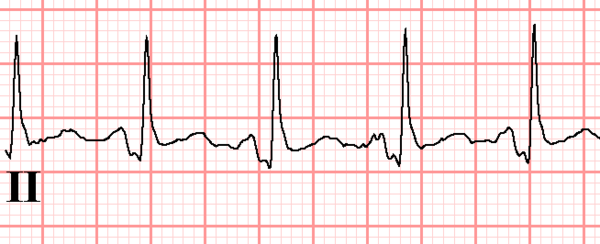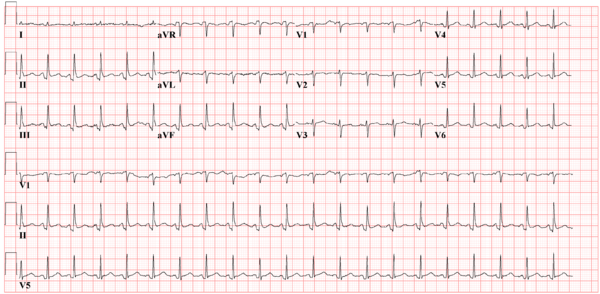Pericarditis: Difference between revisions
Jump to navigation
Jump to search
No edit summary |
No edit summary |
||
| Line 4: | Line 4: | ||
[[Image:12leadpericarditis.png|thumb| Another 12 lead example of pericarditis.]] | [[Image:12leadpericarditis.png|thumb| Another 12 lead example of pericarditis.]] | ||
Pericarditis is an inflammation of the pericardium. This can lead to ST elevation in all leads. Therefore, it is important to distinguish pericarditis from a [[myocardial infarction]], which has more acute complaints and ST-elevations are limited to the infarct area. | |||
In pericarditis four stages can be distinguished on the ECG: | In pericarditis four stages can be distinguished on the ECG: | ||
| Line 14: | Line 14: | ||
Keep into account that in stage I pericarditis, ST-elevation is present in all leads except in aVR, V1 and III. | Keep into account that in stage I pericarditis, ST-elevation is present in all leads except in aVR, V1 and III. | ||
{{clr}} | {{clr}} | ||
==External Links== | |||
[[w:Pericarditis|Pericarditis]] on Wikipedia | |||
Revision as of 21:55, 17 December 2007




Pericarditis is an inflammation of the pericardium. This can lead to ST elevation in all leads. Therefore, it is important to distinguish pericarditis from a myocardial infarction, which has more acute complaints and ST-elevations are limited to the infarct area.
In pericarditis four stages can be distinguished on the ECG:
- stage I: ST elevation in all leads. PTa depression (depression between the end of the P-wave and the beginning of the QRS- complex)
- stage II: pseudonormalisation (transition)
- stage III: inverted T-waves
- stage IV: normalisation
Keep into account that in stage I pericarditis, ST-elevation is present in all leads except in aVR, V1 and III.
External Links
Pericarditis on Wikipedia